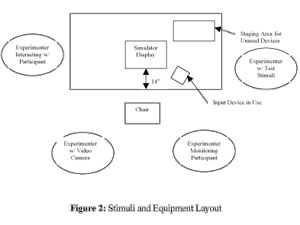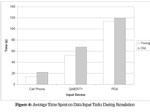The Effects of Input Devices on Driving Tasks

Diagram of user test setup including people and equipment
Skills Used
- Test Plan Creation
- User Testing
- Statistical Data Analysis
Goal
This project was part of the class "Human Factors in Computer Systems" in the College of Engineering.
Considering the advances in and popularity of mobile technology, our goal for the project was to evaluate how well people can drive and use input devices at the same time. For safety reasons, we were prohibited from conducting tests with a person actually driving.
What we did
The first challenge for this project was to create a driving simulation that we could use to perform our tests.  Our first inclination was to use a driving video game with a wheel controller, however once we collected all the materials and tested it out, we realized that controlling the game car was very difficult (none of us could do it) and therefore would not be a satisfactory simulation. We then decided to focus on simulating the attentional aspects of driving rather than the physical. Our final test plan consisted of a custom Visual Basic program that contained a small red box inside a larger white box. The user was told to keep their cursor inside the red box, which moved horizontally across the screen. The subjects were told that going outside the box simulated going outside of the lane while driving. The program recorded the amount of time the cursor was inside and outside of the box, giving us an on-target percentage.
Our first inclination was to use a driving video game with a wheel controller, however once we collected all the materials and tested it out, we realized that controlling the game car was very difficult (none of us could do it) and therefore would not be a satisfactory simulation. We then decided to focus on simulating the attentional aspects of driving rather than the physical. Our final test plan consisted of a custom Visual Basic program that contained a small red box inside a larger white box. The user was told to keep their cursor inside the red box, which moved horizontally across the screen. The subjects were told that going outside the box simulated going outside of the lane while driving. The program recorded the amount of time the cursor was inside and outside of the box, giving us an on-target percentage.
We also set up our test area (shown in main image above) and recruited users. The ages of our users varied from young adults to senior citizens. We analyzed data in two groups - the "younger" group consisted of subjects age 16 to 40. The "older" group consisted of subjects over 40. The input devices we tested were a cell phone, a PDA, and a laptop. The PDA and laptop tasks were identical realistic text messages that a person might try to type while in the car. Because the messages were identical, we were able to compare the ease of use of the two input devices while driving.
We recorded all testing sessions with video and used that video to analyze our results and record times which were also recorded with the Visual Basic program. The Soukoreff and MacKensie keystroke model was used to analyze error in the input devices. Our results were somewhat predictable: the devices that caused the greatest decline in driving ability were the PDA followed by the laptop. It took significantly more time for the subjects to complete the PDA task, and they were much more prone to error. This suggests that input devices requiring a stylus are require more attention than other devices and should be avoided in situations where the user must be paying attention to something else.
Group Members
- I. Gibbs
- R. Marin
- G. Sutter

